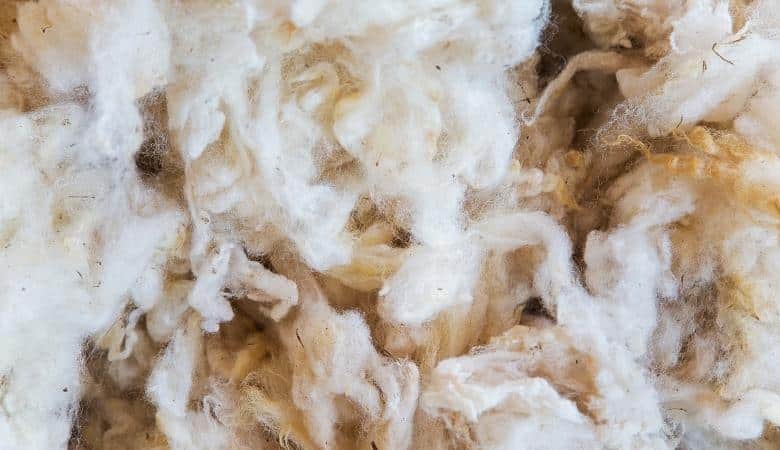This post is a part of the complete wool pillow buyers guide
There are some of us who find it difficult to sleep with covers on top of us. We tend to be hot sleepers and need every bit of air possible to make it through the night. We turn on fans, open the windows, anything to stay cool.
So the thought of sleeping with wool is utterly ridiculous to us, even unimaginable. Who would want wool pillows if they are hot sleepers?
Wool fiber would be more conducive for people who needed to be warm during the night, right? Not necessarily.
Wool is a permeable fabric, which means it allows moisture to pass through the core of the fibers. What this does is help our body to regulate its own temperature so we can feel warm when it’s chilly outside and cool and comfortable when it’s hot outside.

Studies Dispel The Myth About Wool
Contrary to what many may believe, for thousands of years, wool has been used to make life comfortable, especially when it’s hot! Wool provides the perfect temperature-controlled sleeping environment, and here’s why:
Studies conducted with a variety of bedding products in various temperatures and humid environments found wool to be the best fiber of them all.
The study confirmed that wool breathes better than synthetics, increases periods of deep REM sleep, helps the body assume a comfortable sleeping temperature quicker, and maintains that comfort for a longer time.
Wool’s Finest Qualities
One of wool’s finest qualities is its ability to maintain a comfortable body temperature, regardless of the season or climate. Wool produces the warmth your body needs in the winter without overheating, and it keeps your body cooler in the summer and on those long summer nights when you can barely breathe on the outside.
Wool’s natural moisture-wicking properties help to keep you nice and cool on the outside. Wool bedding works like a personal heating and cooling system and is perfect for anyone who experiences night sweats often.
Think of wool as a foam cooler that keeps your food or drinks warm or cold, depending on which one you need at the time. That’s what wool does for your body. That’s what sleeping on a wool pillow does for your upper body, your head, and neck and shoulder area. Wool keeps it all in perspective to allow for a comfortable night of sleep.
How Wool Works

It’s no coincidence wool works in this manner. The fiber has distinct properties that make it different from other textiles. It belongs to a group of proteins called keratins. Its cells form a complex structure composed of amino acids and acidic carboxyl.
This heterogeneous composition is the reason wool behaves differently from other textiles. Wool’s surface is scaly because of its overlapping cuticles, while other textile fibers have a smooth surface. This physical attribute of wool fibers makes it easier to spin and has several other advantages that other fibers can’t match.
Some of those advantages include:
- Wool is resistant to fire.
- Wool will self-extinguish when removed from a fire.
- Wool is flexible.
- Wool is durable to the point that one fiber can be bent back more than 20,000 times without breaking; it’s an insulator keeping your body warm or cool when it needs to.
The fibers in wool create a lining of still air, one of the best insulators nature has to offer. The little pockets of air create a dry layer of air next to your body to hold in heat during colder months and cool your body as the temperature rises.
Our body naturally absorbs moisture. Wool helps this process by drawing moisture from the body during sleep, absorbing it into cells, and reducing skin temperature.
That makes it easy to sleep. When you’re cooler, you toss and turn less often, and you can sleep more peacefully in a deeper REM state. Likewise, in the summer, the treacherous heat is kept away from your body because of wool’s insulating barrier of air pockets. Consider your wool pillow an air conditioner for your body.
Where Does The Moisture Go?
The average sleeper can give off nearly a pint of water vapor while they sleep. Wool can absorb up to 30% of its own weight without feeling damp or clammy. The cells of wool fibers can quickly and efficiently absorb and evaporate moisture, unlike other pillow types. Getting the moisture off your body is the key element to keeping warm in adverse conditions.
Most pillows hold moisture in, and that creates mildew. But, with chemically untreated wool, not only do you limit the threat of mildew under your head, you’ll never be too hot or too cold when you’re sleeping.
Wool Pillows: A Complete Buyers Guide – Parts:
1. Why Use a Wool Pillow? The Benefits & Drawbacks
2. Wool vs. Down Pillows: Similarities, Differences & Which to Choose
3. How Long Do Wool Pillows Last? This is The Replacement Time
4. Do Wool Pillows Sleep Hot or Cool? Or Both Depending on The Climate?
5. Why do Wool Pillows Get Lumpy? How to “Unlump” Them
6. How to Soften a Wool Pillow: Step by Step Guide
7. How to Wash And Dry a Wool Pillow: Step by Step Guide
8. Best Wool Pillows of 2022 – Complete Review
